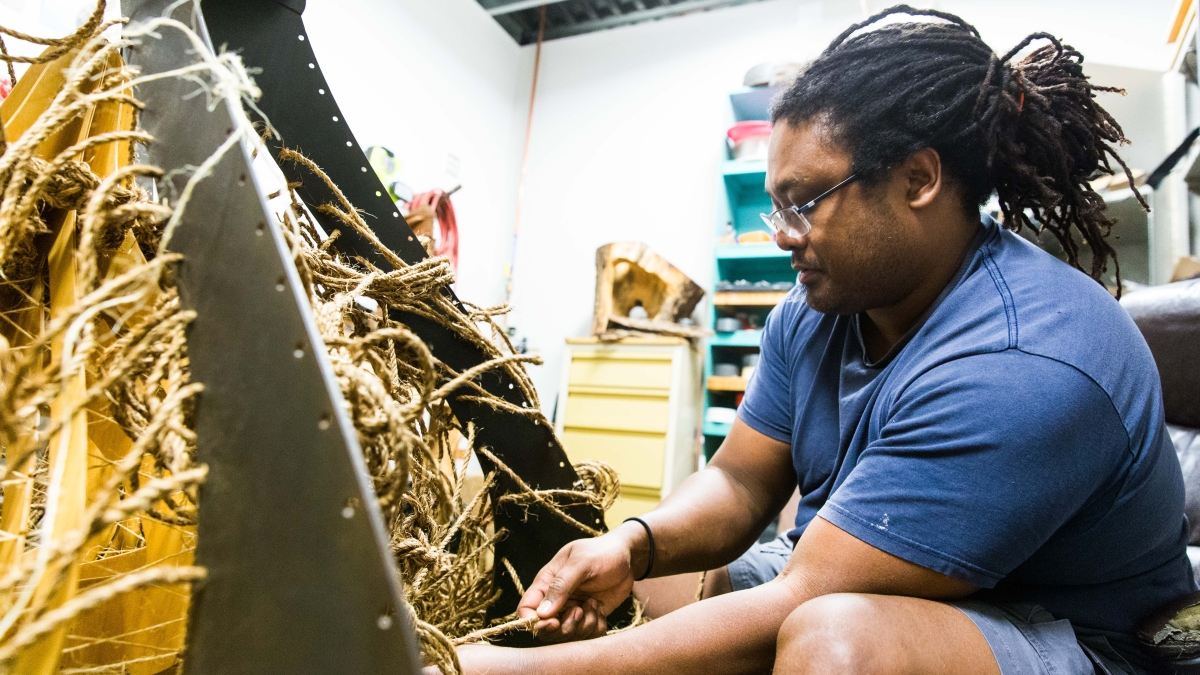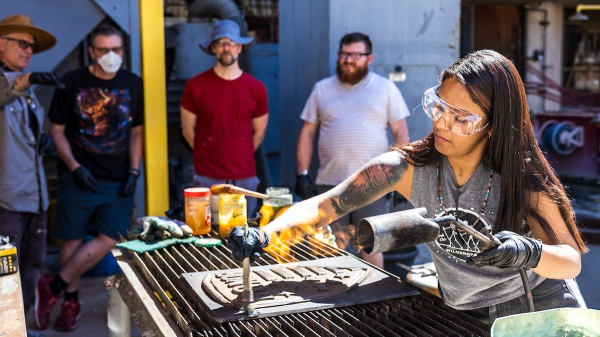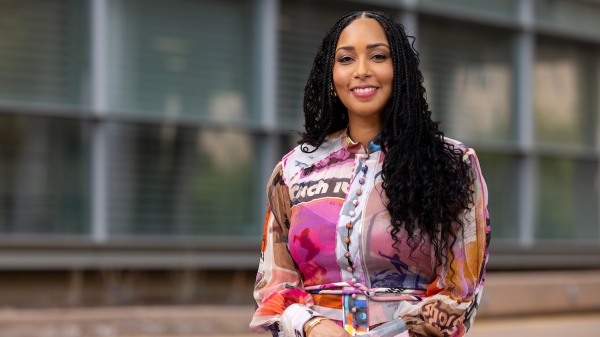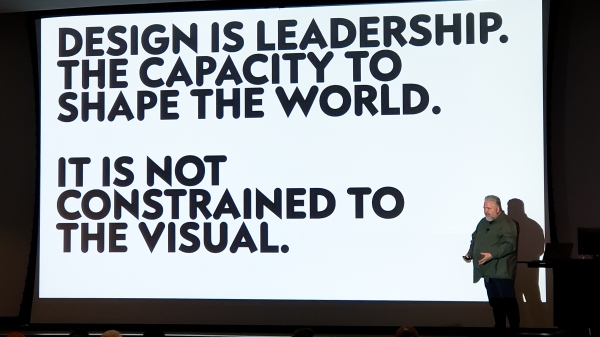ASU grad student blends high tech and handcraft to forge his own artistic identity

ASU School of Art grad student Alvin Huff works on a sculpture combining rope and steel at Grant Street Studios. Photo by Deanna Dent/ASU Now
Editor’s note: This is part of a series of profiles for spring 2018 commencement.
The son of an African-American father from Macon, Georgia, and a Filipino mother from Samar, Alvin Huff grew up in Phoenix, where, he told an interviewer, he dealt with racist slurs and the question of identity.
“I didn’t know it was a question, but it was a question,” he said. “I don’t think it was until I was into my 20s that I realized that identity — it can be given to you — but to a greater degree as you get older, it’s something that you need to define.”
After earning a Bachelor of Arts in philosophy from Brown University in 1997, Huff joined the Peace Corps and spent time in the Philippines, then traveled through southeast Asia, where he came to appreciate ancient architecture.
When Huff returned to Phoenix, he decided his next goal was to earn a master’s degree in something “more creative.” To afford the ASU degree, he found a job at the university. He got his start working for the Arizona Board of Regents, then moved to the Biodesign Institute. Today he’s a system support analyst with the University Technology Office. He works full time, primarily with staff and faculty, supporting their computing needs, from classrooms to research.
“It was difficult balancing [work and school] simply because of the amount of time needed to do them both well,” Huff said. But as he became more focused and skilled, he says, his aesthetic became clearer and the balancing act got a little bit easier.
Huff was selected to participate in the Digital Stone Project, a monthlong international artists residency in central Italy, in 2015. The sculpture he produced for the Digital Stone Project was then exhibited for a month in Florence, Italy.
"Contructs," Huff's Master of Fine Arts in scultpure thesis exhibition, was inspired by organic life and by cultural iconography. It blended contemporary 3D design, computer-controlled fabrication and traditional handcraft into something remarkable, unique and unmistakably Huff’s.
Video by Deanna Dent/ASU Now
Question: What was your “aha” moment, when you realized you wanted to study the field you majored in?
Answer: I decided to take a class with the School of Arts, Media and Engineering called Interactive Environment. I was already working in the IT field, but wanted to develop myself in a more creative way. That class was kind of my “gateway drug” into sculpture. I placed a critical eye on my final project and realized that I could do better. I could take the project farther if I knew how to weld steel. From there, I decided to move away from computer-related creative projects and got into older traditions like casting metal (foundry) and blacksmithing.
Q: What’s something you learned while at ASU — in the classroom or otherwise — that surprised you, that changed your perspective
A: Unless you are independently wealthy or OK with your art just being a hobby, then your artistic practice has to be a business.
Q: What’s the best piece of advice you’d give to those still in school?
A: You don’t need to figure it all out. Just be interested/engaged in where you are and what you are doing. If you can’t do the latter, go back to your happy place, choose another direction and begin again.
Q: What was your favorite spot on campus, whether for studying, meeting friends or just thinking about life?
A: Sculpture workshop.
Q: What are your plans after graduation?
A: Figure out studio space post-Grant Street Studios and then crack the public-art nut.
Q: If someone gave you $40 million to solve one problem on our planet, what would you tackle?
A: I would create an endowment to support and promote public gardens, with a goal of connecting us to place, to local community and to food education — and it would also double as a sculpture garden. It would be a place for food trading (bartering) as well as farmers markets, partnering with public parks, vacant city lots and public schools. And somehow each garden would incorporate a Slip 'N Slide as part of the irrigation system.
More Arts, humanities and education

'Devils in the Metal': ASU vet leads iron cast workshop for former service members
Bruce Ward believes everyone has a symbol of strength or resilience, and they have an obligation to find it. His happens to…

ASU English professor wins Guggenheim Fellowship for poetry
The awards — and opportunities — keep piling up for Safiya Sinclair, an associate professor in Arizona State University’s…

Designer behind ASU’s brand named newest Herberger Institute Professor
Bruce Mau, co-founder and CEO of the Chicago-based holistic design consultancy Massive Change Network, has joined Arizona State…